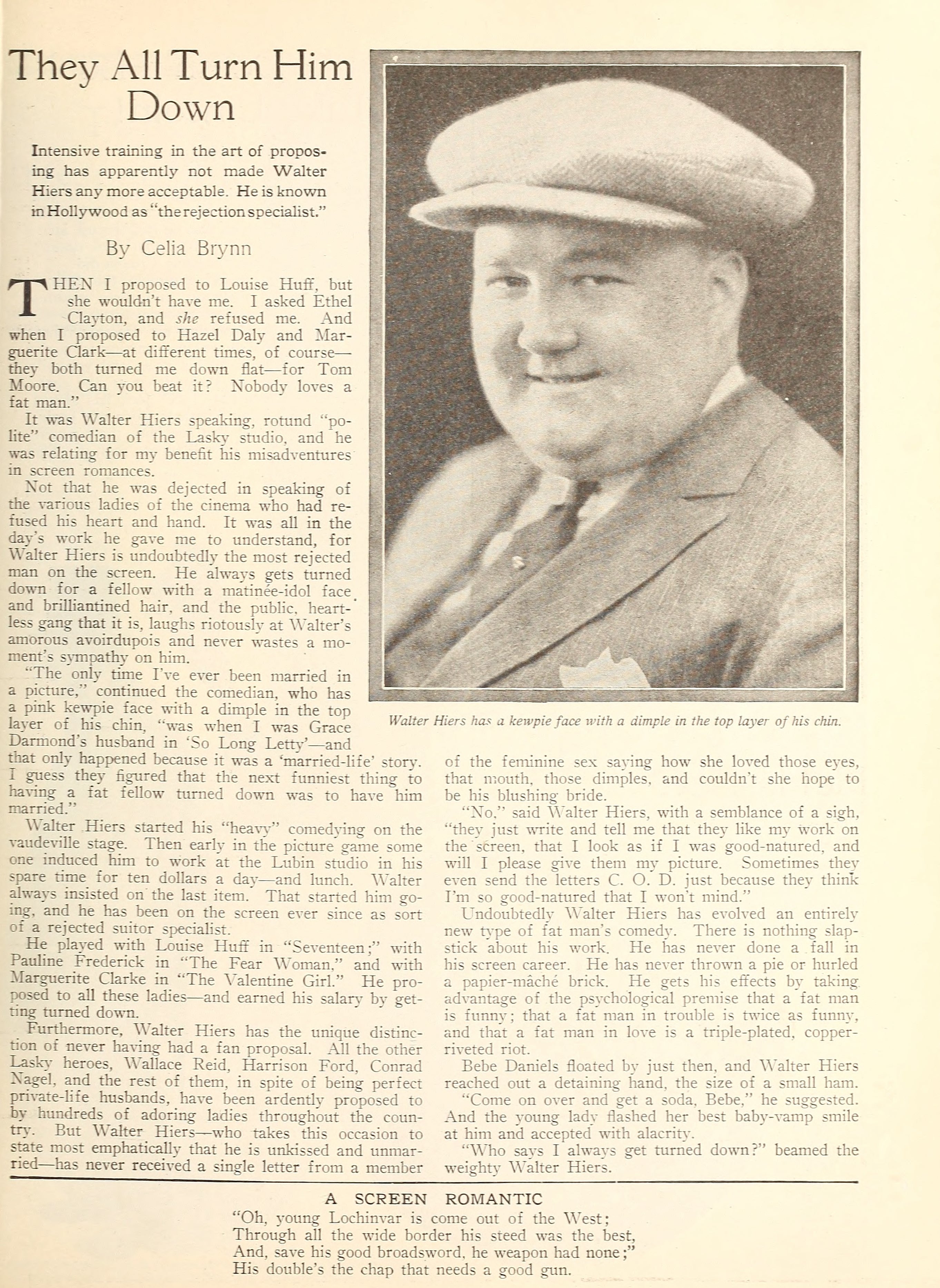Walter Hiers — They All Turn Him Down (1921) 🇺🇸

Then I proposed to Louise Huff, but she wouldn’t have me. I asked Ethel Clayton, and she refused me. And when I proposed to Hazel Daly and Marguerite Clark — at different times, of course — they both turned me down flat — for Tom Moore. Can you beat it? Nobody loves a fat man.”
by Celia Brynn
It was Walter Hiers speaking, rotund “polite” comedian of the Lasky studio, and he was relating for my benefit his misadventures in screen romances.
Not that he was dejected in speaking of the various ladies of the cinema who had refused his heart and hand. It was all in the day’s work he gave me to understand, for Walter Hiers is undoubtedly the most rejected man on the screen. He always gets turned down for a fellow with a matinee-idol face and brilliantined hair, and the public, heartless gang that it is, laughs riotously at Walter’s amorous avoir dupois and never wastes a moment’s sympathy on him.
“The only time I’ve ever been married in a picture,” continued the comedian, who has a pink kewpie face with a dimple in the top layer of his chin, “was when I was Grace Darmond’s husband in So Long Letty — and that only happened because it was a ‘married-life’ story. I guess they figured that the next funniest thing to having a fat fellow turned down was to have him married.”
Walter Hiers started his “heavy” comedying on the vaudeville stage. Then early in the picture game some one induced him to work at the Lubin studio in his spare time for ten dollars a day — and lunch. Walter always insisted on the last item. That started him going, and he has been on the screen ever since as sort of a rejected suitor specialist.
He played with Louise Huff in Seventeen; with Pauline Frederick in The Fear Woman, and with Marguerite Clarke in The Valentine Girl. [Transcriber’s Note: Walter Hiers is not listed in the cast of this movie] He proposed to all these ladies — and earned his salary by getting turned down.
Furthermore, Walter Hiers has the unique distinction of never having had a fan proposal. All the other Lasky heroes, Wallace Reid, Harrison Ford, Conrad Nagel, and the rest of them, in spite of being perfect private-life husbands, have been ardently proposed to by hundreds of adoring ladies throughout the country. But Walter Hiers — who takes this occasion to state most emphatically that he is unkissed and unmarried — has never received a single letter from a member of the feminine sex saying how she loved those eyes, that mouth, those dimples, and couldn’t she hope to be his blushing bride.
“No,” said Walter Hiers, with a semblance of a sigh, “they just write and tell me that they like my work on the screen, that I look as if I was good-natured, and will I please give them my picture. Sometimes they even send the letters C.O.D. just because they think I’m so good-natured that I won’t mind.”
Undoubtedly Walter Hiers has evolved an entirely new type of fat man’s comedy. There is nothing slapstick about his work. He has never done a fall in his screen career. He has never thrown a pie or hurled a papier-maché brick. He gets his effects by taking advantage of the psychological premise that a fat man is funny; that a fat man in trouble is twice as funny, and that a fat man in love is a triple-plated, copper-riveted riot.
Bebe Daniels floated by just then, and Walter Hiers reached out a detaining hand, the size of a small ham.
“Come on over and get a soda, Bebe,” he suggested. And the young lady flashed her best baby-vamp smile at him and accepted with alacrity.
“Who says I always get turned down?” beamed the weighty Walter Hiers.

Walter Hiers has a kewpie face with a dimple in the top layer of his chin.
A Screen Romantic
“Oh, young Lochinvar is come out of the West;
Through all the wide border his steed was the best,
And, save his good broadsword, he weapon had none;”
His double’s the chap that needs a good gun.
Collection: Picture Play Magazine, July 1921
